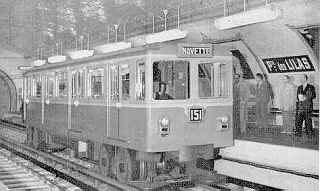| Page
principale de Marc Dufour |
Rail et transports urbains |
Métro de Montréal | Écrivez- moi |
Statistiques d'accès |
|||
![]()
|
The principle behind the rubber-tired metro History  At left : The first ever rubber-tired parisian Métro at the Porte-des-Lilas station. At left : The first ever rubber-tired parisian Métro at the Porte-des-Lilas station.
Rubber-tired Métros were first invented by the Régie Autonome des Transports Parisiens in order
to allow better acceleration peformance so to increase the service
frequency, as well as minize noise and vibrations towards neighbouring
buildings.
With the experience gained on main line railroads on both sides of the
Atlantic with the famous Michelines, the legendary rubber-tired
light trains, the RATP started in 1951 to experiment with a
rubber-tired motor, the "151". The experiment occured on the
Porte-des-Lilas_Pré-Saint-Gervais "shuttle", which was closed to the
travelling public since 1939 and was only used for motorman training.
For the record, the Michelines ran on a classic track, and given the
small rail-tire contact surface and low axle load permitted by the pneumatic
tires, they had to have a high number of axles for a reduced load. But the
Michelines did not last long despite their well-cushioned ride, since
they were particularly sensitive to track defects that could result in...
flat tires...
But what was bad for mainlines wasn't necessarly so for urban subways stuck
with a tremenduous traffic increase since the end of the war...
The captive rolling stock and urban subway network constraints allowed the
RATP to use a axle count reducing solution, by using special rolling
stock rolling on a specially modified track.
Instead of going on the metal rail, wider tires rest on a new track on the
outside of the classic rails that are nevertheless retained to allow classic
rolling stock to go, and in case of a flat tire to take over from the
failure of a tire, since the rubber-tired cars keep their classic metal rail
wheels. Direction is maintained by using horizontal guide wheels that roll
against guide rails that double as power supply feed lines.
Direction control at switches is effected by the extended metal wheel
flanges that rub against the switch points. Originally in Paris, the main
tire rollways were removed at switches, but in Montréal, the main tires are
bearing the weight of the trains on the switches.
Fully satisfied with experimenting with the M151, the RATP started by
converting line 11 (Châtelet_Mairie-des-Lilas) to rubber-tired
operation, and then to convert lines 1, 4 and 6. But the time required to
convert a line and advances made in suspensions, electric traction control
systems and full motorization (powering all the axles of a train) diminished
the advantages of a rubber-tired Métro, and Parisian Métro line conversions
gave way to newer steel wheel rolling stock.
In fact, only new Métro systems (Lyon, Marseille, Montréal, Mexico,
Monterrey) were done using rubber tired trains, as converting existing
systems has been proven uneconomic.
|
| A | Main tire The full weight of cars as well as the whole tractive effort is normally borne by the main tires. For fire resistance reasons and to avoid corrosion of the radial frame, they are inflated with nitrogen. |
| A' | Concrete rollway The main tires run on this track, which is directly fastened to the tunnel floor. At switch points and frogs, they are made of metal. |
| B | Guide wheels Those smaller tires are mounted horizontally and guide the trucks and cars on the track by resting against the guide bars. |
| B' | Guide bars They both guide the trucks on the track and provide the traction current. They are continuously supplied with power (they are, in essence, the third rail) and are supported by insulators (D). The voltage in Montréal is 750 volts. |
| C | Safety wheel In case of a flat tire, they get down and contact the metal rail. In switches, the points touche the flanges and guide the trucks on the lined-up route. They actually have an extended flange as pictured so to keep contact with switch points when the bottom of the wheel does not touch the top of the rail. |
| C' | Metal rail A run-of-the-mill railroad track, down to the stantard gauge (1.435m - 4' 8" 1/2). They are both a safety rail in case of flat tires and are used by some work equipment; they are finally used as the current return path. |
| D | Guide bar insulators They electrically insulate the guide bars and support them and the lateral efforts to keep the trains on the track. |
| E | Rail insulators They electrically insulate the metal rails that carry the current return, and bear the full weight of rolling stock that rolls on them. Metal rails are electically insulated from the tunnel floor, to avoid stray current and their galvanic corrosion problems. They are NOT considered as grounded, and therefore personnel is instructed to consider them with the same attention afforded to the guide rails. |
| F | Lateral pickup shoe They take the traction power from the guide bars. |
| G | Return shoes They return the traction power to the metal rails. |
| H | Flat tire detector When a tire is deflated and the safety wheel contacts the metal rail, the flange goes down very low and mechanically contacts the detection limit switch which, once triggered, sends the alarm signal. |
| Big thanks to Mr. S. Gambourg & M. Walton for correcting small errors and omissions. |
| Fin de la page | Commentaires? mailto:Marc.Dufour@emdx.org — Statistiques d'accès |